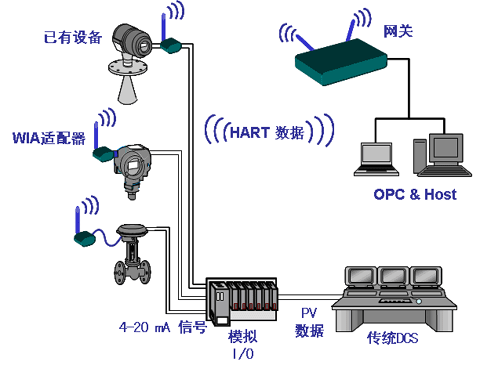 Recently, the WIA-PA technical standard for industrial wireless networks led by the Shenyang Institute of Automation, Chinese Academy of Sciences, was voted by 26 P member countries of the International Electrotechnical Commission's Industrial Process Measurement, Control, and Automation Technology Committee IEC/TC65. The final proposal was 100%. The pass rate has become the official IEC international standard: IEC 62601 Ed.1: Industrial Communication Networks - Fieldbus Specifications - WIA-PA Communication Network and Communication Profile (WIA-PA Communication Network and Communication Profile for Industrial Communication Network Fieldbus Specification).
Recently, the WIA-PA technical standard for industrial wireless networks led by the Shenyang Institute of Automation, Chinese Academy of Sciences, was voted by 26 P member countries of the International Electrotechnical Commission's Industrial Process Measurement, Control, and Automation Technology Committee IEC/TC65. The final proposal was 100%. The pass rate has become the official IEC international standard: IEC 62601 Ed.1: Industrial Communication Networks - Fieldbus Specifications - WIA-PA Communication Network and Communication Profile (WIA-PA Communication Network and Communication Profile for Industrial Communication Network Fieldbus Specification). Industrial wireless network technology is the most active mainstream development direction in the field of Internet of Things technology, and it is a revolutionary technology that affects the future development of the manufacturing industry. Industrial wireless technology emerged in the beginning of this century. It supports low-cost, high-reliability, highly flexible next-generation ubiquitous manufacturing information systems and environments by supporting the interaction and connection between devices, and promotes the expansion and enhancement of the functions of industrial information systems. It is an important enabler technology for improving production efficiency, improving product quality, saving energy, and reducing emissions. For this reason, industrial wireless network technology has attracted the attention of the world’s advanced industrial countries. In 2000, the U.S. Department of Energy and the President’s Science and Technology Commission listed industrial wireless technology as one of the main technical means to achieve a 5% reduction in overall energy consumption in the US industry by 2020 and a 20% reduction in emissions. According to ON World, an authoritative organization for network technology market analysis in the United States, nearly 20 million industrial wireless network nodes will be put into use around the world in 2014. The output value will reach several billion US dollars, and it will grow rapidly. Among them, the fastest growing market is Petroleum, chemical, power grid and other important industries.
China is also one of the countries in the world that carried out research and application of industrial wireless network technology earlier. At the beginning of this century, the National Natural Science Foundation of China began to provide support in the basic theory and technology of sensor networks and laid the foundation for related research work. With the maturing of application conditions of sensor networks in the industrial field, the independent industrial wireless network technology system has become a research hotspot in the field of industrial automation. In the critical period of development of international industrial wireless technology, the Ministry of Science and Technology and the Academy of Sciences successively launched a key support program for industrial wireless technology in 2006. Leaded by Shenyang Institute of Automation, Chinese Academy of Sciences, Jointly Zhejiang University, Institute of Instrument and Meter Technology, Beijing University of Science and Technology, Chongqing University of Posts and Telecommunications, Shenyang Zhongkebo Micro Automation Technology Co., Ltd., Shanghai Institute of Industrial Automation Instrumentation, Northeastern University Nearly 20 companies, such as Southwest University and Dalian University of Technology, established the Industrial Wireless Alliance, conquering the technical difficulties in the reliability, real-time, and low-power consumption of wireless technologies in industrial measurement and control applications, and formed independent intellectual property rights. The core technology has built a core autonomous technology system consisting of more than 50 patents, and has successfully demonstrated applications in the fields of chemical engineering and oil production, marking that China's industrial wireless technology has entered a new stage of development.
On this basis, the National Ministry of Science and Technology, the National Standards Commission and other relevant departments have meticulously organized and actively promoted the international standardization of industrial wireless technologies. The Shenyang Institute of Automation of the Chinese Academy of Sciences, led by the National Industrial Process Measurement and Control Standardization Technical Committee, carried out the research on the "national wireless communication technology" national standard system and the drafting of key standards. In October 2008, the standards drafting team completed the draft of the WIA-PA national standard and was approved in December 2010. On July 29, 2011, WIA-PA was released as the national standard of the People's Republic of China GB/T 26790.1 -2011. The drafting of the WIA-PA International Standards was in parallel with the national standards. In May 2008, IEC/TC65 established the WIA-PA International Standards Drafting Project Team. Germany, France, the United States, Japan, and Sweden all appointed experts to participate in the WIA-PA International Standards Drafting Project Team, and launched the WIA-PA IEC formal international standard. Formulate work. On October 31, 2008, the WIA-PA specification was issued as a publicly available specification IEC/PAS 62601 after voting by all IEC members. The final International Standard Draft (FDIS) voted on October 14, 2011, and WIA-PA became the official IEC international standard, becoming one of the only two official international standards in the field of industrial wireless.
China's WIA-PA technology with independent intellectual property rights has become an international standard and it is of great significance, marking that in the field of industrial wireless, China has become one of the leading countries in technology. The application of WIA-PA technology will help reduce the risks associated with the production and use of related products, ensure industrial safety, expand the market share of automation products in related fields in China, and provide high-end solutions for the integration of industrialization and information technology. China's industrial energy-saving emission reduction targets.
GPS Personal Tracker Co., Ltd. , http://www.szgpstracker.com
